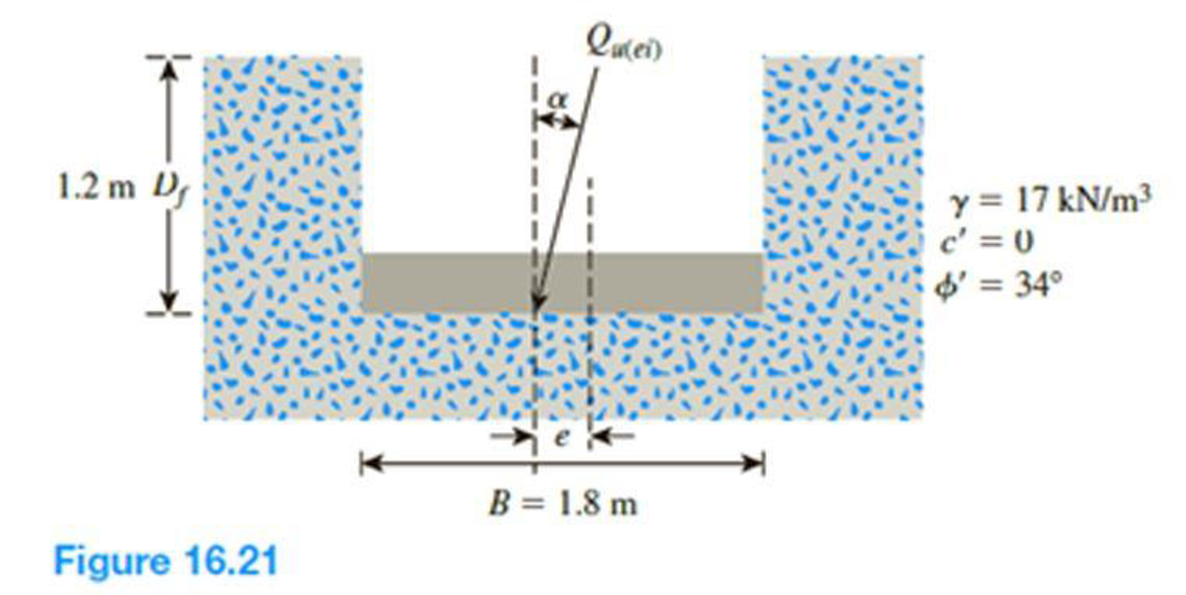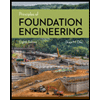
Concept explainers
Figure 16.21 shows a continuous foundation with a width of 1.8 m constructed at a depth of 1.2 m in a granular soil. The footing is subjected to an eccentrically inclined loading with e = 0.3 m, and α = 10°. Determine the gross ultimate load, Qu(ei), that the footing can support using:
- a. Meyerhof (1963) method [Eq. (16.52)]
- b. Saran and Agarwal (1991) method [Eq. (16.53)]
- c. Patra et al. (2012) reduction factor method [Eq. (16.54)]

(a)
The gross ultimate load
Answer to Problem 16.19P
The gross ultimate load
Explanation of Solution
Given information:
The unit weight of the soil
The value of cohesion
The soil friction angle
The location of depth of footing base
The width of the footing B is 1.8 m.
The value of eccentricity e is 0.3 m.
The inclined angle
Calculation:
Determine the effective width of the footing using the relation.
Substitute 1.8 m for B and 0.3 for e.
For the continuous foundation, all shape factors are equal to one
Determine the depth factor
Substitute 1.2 m for
Determine the depth factor
Substitute
Determine the inclination factor
Substitute
Determine the inclination factor
Substitute
Determine the ultimate bearing capacity of the soil
Here,
Refer Table 16.2, “Bearing-capacity factors
For
The values of
Substitute 0 for
Determine the gross ultimate load
Substitute
Therefore, the gross ultimate load
(b)
The gross ultimate load
Answer to Problem 16.19P
The gross ultimate load
Explanation of Solution
Given information:
The unit weight of the soil
The value of cohesion
The soil friction angle
The location of depth of footing base
The width of the footing B is 1.8 m.
The value of eccentricity e is 0.3 m.
The inclined angle
Calculation:
Determine the ratio of
Substitute 0.3 for e and 1.8 m for B.
Determine the gross ultimate load
Here,
Refer Figure 16.14, “Variation of
Take the
Refer Figure 16.15, “Variation of
Take the
Refer Figure 16.16, “Variation of
Take the
Substitute 0 for
Therefore, the gross ultimate load
(c)
The gross ultimate load
Answer to Problem 16.19P
The gross ultimate load
Explanation of Solution
Given information:
The unit weight of the soil
The value of cohesion
The soil friction angle
The location of depth of footing base
The width of the footing B is 1.8 m.
The value of eccentricity e is 0.3 m.
The inclined angle
Calculation:
For the continuous foundation, all shape factors are equal to one
Determine the depth factor
Substitute 1.2 m for
Determine the depth factor
Substitute
Determine the ultimate bearing capacity of the soil
Refer Table 16.2, “Bearing-capacity factors
Take the
Substitute 0 for
Determine the gross ultimate load
Substitute 1.8 m for B,
Therefore, the gross ultimate load
Want to see more full solutions like this?
Chapter 16 Solutions
Principles of Geotech... - With Lms Mindtap (1 Sem)
- Consider a continuous foundation of width B = 1.4 m on a sand deposit with c = 0, = 38, and = 17.5 kN/m3. The foundation is subjected to an eccentrically inclined load (see Figure 6.33). Given: load eccentricity e = 0.15 m, Df = 1 m, and load inclination = 18. Estimate the failure load Qu(ei) per unit length of the foundation a. for a partially compensated type of loading [Eq. (6.89)] b. for a reinforced type of loading [Eq. (6.90)]arrow_forwardConsider a continuous foundation of width B = 1.4 m on a sand deposit with c' = 0, Φ' = 38° and γ = 17.5 kN/m3. The foundation is subjected to an eccentrically inclined load (see Figure 4.31). Given: load eccentricity e = 0.15 m, Df = 1 m, and load inclination β = 18°. Estimate the failure load Qu(ei) per unit length of the foundation a. for a partially compensated type of loading [Eq. (4.85)] b. for a reinforced type of loading [Eq. (4.86)]arrow_forwardSolve Problem 7.8 using Eq. (7.29). Ignore the post-construction settlement. 7.8 Solve Problem 7.4 with Eq. (7.20). Ignore the correction factor for creep. For the unit weight of soil, use γ = 115 lb/ft3. 7.4 Figure 7.3 shows a foundation of 10 ft × 6.25 ft resting on a sand deposit. The net load per unit area at the level of the foundation, qo, is 3000 lb/ft2. For the sand, μs = 0.3, Es = 3200 lb/in.2, Df = 2.5 ft, and H = 32 ft. Assume that the foundation is rigid and determine the elastic settlement the foundation would undergo. Use Eqs. (7.4) and (7.12).arrow_forward
- A 2.0 m wide continuous foundation carries a wall load of 350 kN/m in a clayey soil where = 19.0 kN/m3, c = 5.0 kN/m2, and = 23. The foundation depth is 1.5 m. Determine the factor of safety of this foundation using Eq. (6.28).arrow_forwardA foundation measuring 1.2 m x 2.4 m in plan is constructed in a saturated clay. Given: depth of embedment of the foundation = 2 m, unit weight of soil = 18 kN/m3, and undrained cohesion of clay = 74 kN/m2. Estimate the ultimate uplift capacity of the foundation.arrow_forwardIn the following example, a rectangular foundation must be designed whose B/L ratio must be equal to 0.5.The ultimate allowable load Qadm that must be transmitted to the ground is 520 KN, using a safety factor of 2.0. Designing with Meyerhoff theory, assume that the soil undergoes a general shear failure process. For this problem, propose values of B and L that meet the B/L ratio until Qadm is found to be equal to 520 kN.arrow_forward
 Principles of Geotechnical Engineering (MindTap C...Civil EngineeringISBN:9781305970939Author:Braja M. Das, Khaled SobhanPublisher:Cengage Learning
Principles of Geotechnical Engineering (MindTap C...Civil EngineeringISBN:9781305970939Author:Braja M. Das, Khaled SobhanPublisher:Cengage Learning Principles of Foundation Engineering (MindTap Cou...Civil EngineeringISBN:9781337705028Author:Braja M. Das, Nagaratnam SivakuganPublisher:Cengage Learning
Principles of Foundation Engineering (MindTap Cou...Civil EngineeringISBN:9781337705028Author:Braja M. Das, Nagaratnam SivakuganPublisher:Cengage Learning Fundamentals of Geotechnical Engineering (MindTap...Civil EngineeringISBN:9781305635180Author:Braja M. Das, Nagaratnam SivakuganPublisher:Cengage Learning
Fundamentals of Geotechnical Engineering (MindTap...Civil EngineeringISBN:9781305635180Author:Braja M. Das, Nagaratnam SivakuganPublisher:Cengage Learning Principles of Foundation Engineering (MindTap Cou...Civil EngineeringISBN:9781305081550Author:Braja M. DasPublisher:Cengage Learning
Principles of Foundation Engineering (MindTap Cou...Civil EngineeringISBN:9781305081550Author:Braja M. DasPublisher:Cengage Learning



